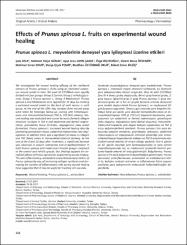Prunus spinosa L. meyvelerinin deneysel yara iyileşmesi üzerine etkileri

View/
Access
info:eu-repo/semantics/openAccessDate
2017Author
Ayla, ŞuleGünal, Yalçın Mehmet
Şakul, Ayşe Arzu Sayın
Özdemir, Musa Ekrem
Okur, Evren Mehmet
Bilgiç, Bülent Emre
Metadata
Show full item recordAbstract
Farelerde oluşturduğumuz deneysel yara modellerinde, Prunus Spinosa L. metanollü meyve ekstresini kullanarak, bu ekstrenin yara iyileşmesindeki etkisini araştırdık. Otuz iki adet C57/Black fare ile 4 deney grubu oluşturuldu. Birinci grup kontrol grubu, 2. grup taşıyıcı (gliserin) grup, 3. grup Prunus spinosa, 4. grup ma- decassol grubu idi ve her bir grupta farelerin sırtında eksizyonel yara modeli oluşturularak Prunus Spinosa L. ve madecassol 10. gün boyunca uygulandı. Onuncu gün sonunda yara bölgeleri his- tolojik takip için alındı, yara dokuları hematoksilen-eosin ve im- munohistokimyasal (TGF-?, COL1A1) boyalarla boyanarak, yara iyileşmesi için epidermal ve dermal rejenerasyon, granülasyon doku oluşumu, anjiogenezis (yeni damar oluşumu), immunohis- tokimyasal boyalarla yeni oluşan kollajen yapılanması ve TGF ? artışı değerlendirilerek skorlandı. Prunus spinosa L’nin yara do- kusunda iyileşme oranlarını, granülasyon dokusunu, epidermal rejenerasyonu ve anjiogenezisi artırarak gösterdiği yine immü- nohistokimyasal boyamalarda kollajen ve TGF ? oranlarında ista- tistiksel olarak anlamlı bir artışın olduğu gözlendi. Yine 4. günün ve 10. günün sonunda yara kontraksiyonunda ve yara yerinin reepitelizasyonunda ilaç ve madecassol grubunda kontrol gru- buna kıyasla anlamlı bir artış gözlenmiştir. Bulgularımız, Prunus spinosa L’nin yara iyileşmesini desteklediğini göstermiştir. Prunus spinosanın antiinflamatuvar, antioksidan ve antibakteriyel etki- si ile, kollajen sentezini artırarak ve inflamatuvar hücre sayısını azaltarak yara iyileşmesinin tedavisinde kullanılabileceğini dü- şündürdü. We investigated the wound healing efficacy of the methanol extracts of Prunus spinosa L. fruits using an excisional cutane- ous wound model in mice. We used 32 C57/Black mice equally divided into four groups. Group 1 Control, Group 2 vehicle (glyce- rine), Group 3 Prunus spinosa L., Group 4 Madecassol. Prunus spinosa L.and Madecassol were applied for 10 days by creating a excisional wound model on the back of each mouse in each group. At the end of the 10th day, samples from wound areas were taken for histologic follow-up, scoring with hematoxylin- eosin and immunohistochemical (TGF-b, COL1A1) staining. Wo- und healing was evaluated and scored by newly formed collagen structure, increase in TGF b and epidermal and dermal regene- ration, granulation tissue thickness, angiogenesis (new vessel formation). Prunus spinosa L. increased wound healing rates by promoting granulation tissue, epidermal regeneration and angi- ogenesis. In addition there was a significant increase in collagen and TGF [beta] ratios in immunohistochemical staining. At the end of the 4 and 10 days after treatment, a significant increase was observed in wound contraction and re-epithelialization in both Prunus spinosa and madecassol treated groups compared to the control and vehicle groups. Our findings support the be- neficial effects of Prunus spinosa for augmenting wound healing. The anti-inflammatory, antioxidant and antibacterial activities of Prunus spinosa by way of increasing collagen synthesis and dec- reasing the number of inflammatory cells during wound healing have suggested that it may be useful for treating skin wounds.
Source
Medeniyet Medical JournalVolume
32Issue
3URI
http://www.trdizin.gov.tr/publication/paper/detail/TWprME5ESTJOZz09https://hdl.handle.net/11421/13325
Collections
- Makale Koleksiyonu [132]
- TR-Dizin İndeksli Yayınlar Koleksiyonu [3512]

















